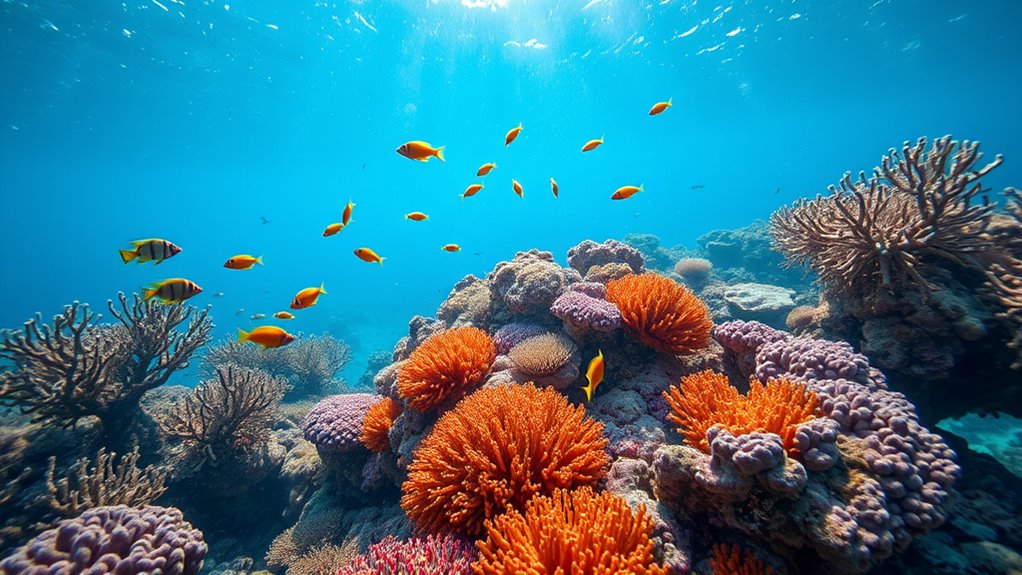Coral reefs can surprisingly recover after mass bleaching events, showing remarkable resilience. This recovery depends on resilient coral species, healthy larvae, and genetic traits that help corals withstand higher temperatures. When ecosystems are protected from local stressors like pollution and overfishing, reefs have a better chance to bounce back. If you want to understand how this natural process works and what future efforts can enhance it, there’s more to discover below.
Key Takeaways
- Coral reefs can naturally recover after bleaching events when resilient species and healthy larvae are present.
- Genetic traits in corals enhance their ability to withstand higher temperatures, supporting recovery.
- Protecting coral biodiversity and reducing local stressors aid natural resilience and facilitate reef regeneration.
- Marine protected areas provide refuges for resilient corals, boosting overall recovery efforts.
- The observed recovery demonstrates the reef’s capacity to rebound when environmental conditions improve.

Have you ever wondered if coral reefs can bounce back from damage? It’s a question many ocean enthusiasts and scientists ask, especially after witnessing the devastating effects of mass bleaching events. Coral reefs are essential habitats that support an incredible range of marine biodiversity, providing shelter, food, and breeding grounds for countless species. When these reefs suffer from stressors like rising sea temperatures, their ability to recover hinges on more than just the survival of corals; it’s about the resilience of the entire ecosystem. Thankfully, recent observations show that some reefs demonstrate remarkable resilience, hinting at hope for the future of marine biodiversity in a changing climate.
Coral reefs can recover, offering hope amid climate change challenges.
The key to understanding this resilience lies in the complex interactions within the ecosystem. After a bleaching event, some corals can recover if conditions improve quickly enough, and this recovery process often depends on the presence of resilient coral species and the availability of healthy larvae to repopulate the area. These resilient corals tend to have genetic traits that help them withstand higher temperatures and other stressors, making them essential for the reef’s long-term survival. When these hardy species dominate, they create a foundation for new coral growth, which in turn attracts various marine creatures, bolstering marine biodiversity. This natural recovery process highlights the importance of protecting and promoting climate resilience within reef systems. Additionally, research into coral adaptation provides valuable insights into ways to enhance their natural resilience, emphasizing the importance of conserving genetic diversity. Studies also suggest that climate resilience strategies can significantly improve the chances of reef recovery after bleaching events.
Furthermore, human intervention can support this recovery. Efforts like reducing local stressors—such as pollution, overfishing, and destructive fishing practices—give reefs a better chance to bounce back after bleaching events. Conservation initiatives that focus on restoring damaged areas and establishing marine protected zones help maintain the conditions necessary for natural resilience to take hold. These actions not only help to safeguard existing biodiversity but also enhance the ecosystem’s ability to adapt to ongoing climate changes. It is also crucial to recognize that marine protected areas can serve as refuges for resilient coral species, increasing the likelihood of recovery.
The resilience of coral reefs demonstrates an impressive capacity to recover, especially when we actively support their recovery through sustainable practices. In addition, ongoing research into coral genetics and adaptive traits offers promising avenues to bolster this resilience through targeted conservation efforts. Protecting the genetic diversity of corals is vital for ensuring that resilient traits can be passed on, helping entire reef systems withstand future stressors. This highlights the significance of genetic diversity in maintaining ecosystem stability and resilience.
In essence, the story of coral reefs isn’t just about destruction but also about hope. While climate change poses serious threats, the resilience shown by many reefs after bleaching events illustrates their potential to recover when given the right conditions. Their ability to bounce back is a testament to the strength of marine biodiversity and the importance of fostering climate resilience. With continued effort and mindful management, these vibrant ecosystems can persist, offering a glimpse of optimism in a warming world. So, yes, coral reefs can and do recover—showing us that even amid adversity, nature’s resilience can prevail. Recognizing the importance of positive thinking in conservation efforts can strengthen our collective resolve to protect these vital ecosystems.
Frequently Asked Questions
How Long Does Coral Reef Recovery Typically Take?
When asking how long coral reef recovery takes, consider coral resilience and reef resilience strategies. Recovery time varies widely—from a few years to decades—depending on factors like water quality, temperature, and protection efforts. You can boost recovery by supporting strategies that enhance resilience, such as reducing pollution and protecting key species. Understanding these elements helps you appreciate that with proper care, reefs can bounce back over time, showcasing nature’s resilience.
Can Human Activity Accelerate Reef Recovery?
You wonder if human activity can speed up reef recovery. It’s possible, but it’s a delicate balance. By supporting coral resilience and implementing reef resilience strategies—like reducing pollution, controlling overfishing, and restoring damaged areas—you can help. These steps may seem small, but they hold the power to tip the scales toward faster recovery. The question remains: will your actions be enough to unleash the reef’s full potential?
What Specific Species Are Most Resilient?
When considering species resilience, you find that some species possess adaptive traits that help them withstand environmental stress, like bleaching. You’ll notice that resilient coral species often have fast growth rates, flexible symbiotic relationships, or tolerances to higher temperatures. These adaptive traits enable them to survive and recover more quickly after disturbances. By identifying these resilient species, you can better understand which corals are most likely to thrive amid climate challenges.
Are There Signs of Future Bleaching Risks?
You might wonder if future bleaching risks are on the horizon. While coral resilience has improved thanks to recovery efforts, scientists monitor bleaching indicators closely. Rising sea temperatures and ocean acidity are concerning signs that could trigger new bleaching events. Staying informed about these indicators helps you understand potential threats and the importance of conservation efforts to protect these crucial ecosystems from future stressors.
How Do Recovery Rates Vary Globally?
You’ll find that recovery rates vary globally due to differences in coral adaptation and reef resilience. Some regions, like parts of the Pacific, show rapid recovery thanks to resilient coral species and effective conservation efforts. Conversely, areas with weaker reef resilience or higher stressors recover more slowly. Understanding these variations helps highlight the importance of supporting coral adaptation strategies to promote faster, more robust recovery worldwide.
Conclusion
You should be encouraged by the coral reef’s resilience, as it shows remarkable recovery after the mass bleaching event. Despite losing over 50% of its coral cover at one point, the reef has bounced back considerably, demonstrating nature’s incredible capacity to heal. This recovery highlights the importance of protecting these essential ecosystems, so they can continue to thrive and support countless marine species for generations to come. Your efforts can help guarantee such remarkable rebounds keep happening.









